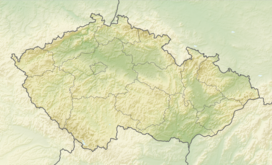Předmostí u Přerova (archaeological site)
| Předmostí u Přerova | |
|---|---|
| Archeological site | |
 | |
| Highest point | |
| Elevation | 250 m (820 ft) |
| Prominence | 35 m (115 ft) |
| Coordinates | 49°27′56″N 17°26′23″E / 49.46556°N 17.43972°E |
| Dimensions | |
| Area | 37 acres (15 ha) |
| Geography | |
| Location | Czech Republic—Moravia |
| Parent range | Moravian Gate/Oderské vrchy |
| Geology | |
| Age of rock | Late Pleistocene |

Předmostí (Skalka) (often without
A fossil site at Předmostí is located near
A fragment of Predmostí 21's mandible was rediscovered in the Museum of Olomouc.[1]
New excavations were conducted.[when?]
The Předmostí site appears to have been a living area with associated burial ground with some 20 burials, including 15 complete human interments, and portions of five others, representing either disturbed or secondary burials.
The Předmostí site is dated to between 24,000 and 37,000 years old. The people had robust features indicative of a big-game hunter lifestyle. They also share square eye socket openings found in the French material. Skulls of Předmostí individuals are significantly longer and more robust than of modern Europeans, with thick brow ridges, and prognathism, and show marked sexual dimorphism.[3] They also display a degree of variability.[4]
History of research

It was here that
-
The Bond pendant
-
Memorial of hunters in situ
-
Old map of Předmostí (Predmost) 1830, earlier than research start
-
Map of Cro-Magnon migration, stage -32 000.
References
- Dolni Vestonice I – the Kiln and Encampment. Don's Maps- Paleolithic European, Russian and Australian Archaeology. Ed. Don Hitchcock.
- Jelínek, J., Pictorial Encyclopedia of the Evolution of Man, Prague: Hamlyn (1975).
- National Geographic Magazine, The National Geographic Society, October 1988.
- Price, T. D., and G. M. Feinman. Images of the past. New York: McGraw-Hill Higher Education, 2010. Print.
- Pringle, Heather. "Ice Age Communities May Be Earliest Known Net Hunters." Science Magazine 277.5300 (1997): 1203–204. Science. Web. Trinkaus, Erik, *Shreeve, James, The Neandertal Enigma: Solving the Mystery of Modern Human Origins, New York: William Morrow and Company (1995).
- Tedlock, Barbara, "The Woman in the Shaman's Body; Reclaiming the feminine in religion and medicine", New York: Bantam Dell, 2005.
- doi:10.4000/bmsap.70.
- ^ Svoboda J.A. (2004). "The Gravettian on the Middle Danube". Paléo – Revue d'archéologie préhistorique. 19: 203–220.
- ^ "Weclcome to the Open Research Scan Archive!".
- PMID 18242606.
Further reading
- VELEMINSKÁ, Jana, BRŮŽEK, Jaroslav (eds.) (2008), Early modern humans from Předmostí. Praha, Academia. ISBN 978-80-200-1586-0
- ABSOLON, Karel,(1929), New finds of fossils human skeleton in Moravia. Archeologie 7, 1–2 p. 79–89
- JELÍNEK, Jan, ORVÁNOVÁ, E.(1999), Předmostí hominid remains. An up-dates. Czech and Slovak republics. In: Orban, R, Semal, F (eds.) Antropologie et Prehistorie, Suppl. 9, p. 70–77





